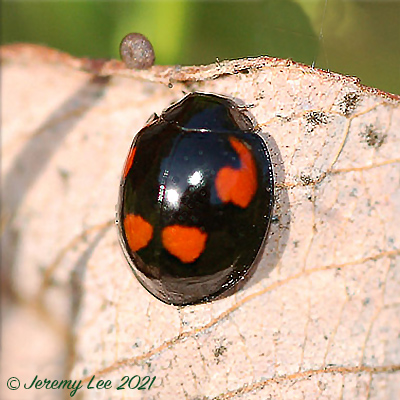
 |
|
Scientific Classifications explained » Amphibians » Ants » Aphids » Bees » Beetles » Birds » Bugs » Butterflies » Caterpillars » Damselflies » Dragonflies » Earwigs » Flies » Frog/Leafhoppers » Fungi » Galls » Grasshoppers » Harvestmen » Hoverflies » Lacewings » Ladybirds » Leaf Mines » Lichens » Mammals » Millipedes » Mosses » Moths » Sawflies » Slugs » Snails » Spiders » Trees & Shrubs » Wasps » Wild Flowers » Woodlice » Postboxes |
UK Nature > Ladybirds > Exochomus quadripustulatus

Scientific Name: Exochomus quadripustulatus Common Name: Pine Ladybird With a length of approximately 4-5mm, Exochomus quadripustulatus is almost circular, convex and shining, with a flange around the base. The color is quite variable and may change with ageing. Usually elytra are black with two larger red comma-shaped spots and two smaller red round or oval spots. The color of these spots can also be orange or yellow, but completely reddish brown specimens may occur. Though mainly found in areas of pinewoods, it also lives on other trees and shrubs, such as Hawthorn when its preferred pine is absent. Adults are active April to October, feeding on aphids and other pests such as scale insects. Adults overwinter in leaf litter, foliage and bark crevices of evergreen trees and shrubs. |
|

https://www.uknature.co.uk is a website dedicated to showing the immense diversity of UK nature and wildlife. Our vast range of habitats, from lowland arable to snow covered mountains, from storm-ravaged coastlines to peaceful inland freshwater lakes and rivers, from dry, sandy heaths to deciduous and coniferous forests, all these habitats contribute to the abundance of UK nature. We have wild birds in huge numbers either residing or visiting our shores (597 recorded species as at July 2013) and we must also not forget the humble back garden with its grass lawns, flower beds filled with nectar rich flowers, shrubs and trees, all designed to attract huge numbers of insects such as bees, moths, butterflies and hoverflies; and finally the small ponds which provide safe havens for frogs, toads, newts and even slow worms and grass snakes. www.uknature.co.uk is the showcase for my personal passion, photographing uknature in all its glory. I sincerely hope you all enjoy the fruits of my labours. This site and all images contained therein is © Jeremy Lee 2004 - 2025. All Rights Reserved. Site design by Jeremy Lee. Site development & IT Support by Stuart Lee. |